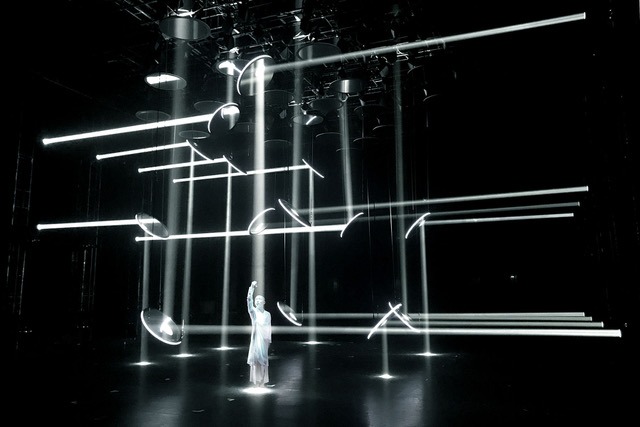Visual artist and Imagineer Christopher Bauder from WHITEvoid created dynamic kinetic installation Mirror-Mirror, featuring contemporary dancer Qui Jirong, making up Apologue 2047/2, directed by Chinese producer and director Zhang Yimou.
Produced by LIVE Kingway at National Centre for the Performing Arts (NCPA) in Beijing and will tour China throughout August allowing a wider audience to experience the mix of Chinese folk arts and modern technology.
For Mirror-Mirror, Christopher utilised 30 Robe Pointes as his primary light sources, which worked in unison with 102 KINETIC LIGHTS WinchLEDpixels and 34 Mirror Disc lighting fixtures.
Each mirror is controlled by three winches which give seven metres of up / down plus pan/tilt, so they can move incredibly smoothly on XY and Z axes making their movement fluid and three dimensional. The mirror movement is controlled via ArtNet by Kinetic Lights’ proprietary KLC software platform and the whole system is networked.
Christopher explained: “In addition to the accuracy of the lighting cues we needed a light with highly calibrated colours that matched perfectly. It had to be a quick moving fixture easy to handle and programme and also readily available. This and the crispness of the emitted light made it perfect for the installation”.
It was an evolutionary process which suited the development of all movement – from the dancer to that of the mirrors and lighting technology. The Pointes are arranged on ladders in three layers, each with five Pointes, running upstage/downstage. Utilizing these traditional dance performance lifting positions was one thing, but the technique was fully subverted with the mirrors which were able to bend, reflect and refract the light beams in any direction in mid-air.
Combining the side-rigged Pointes with the moving mirrors massively increased the flexibility of the precisely positioned lighting fixtures.
Christopher added: “I really maxed out the Pointes on Mirror-Mirror, we could vary the looks infinitely with different gobos, strobing effects, frosts, etc., adding that the biggest challenge at the NCPA had in fact been pumping enough haze into the performance area in three minutes as that was all they had for between segment changeovers.”





